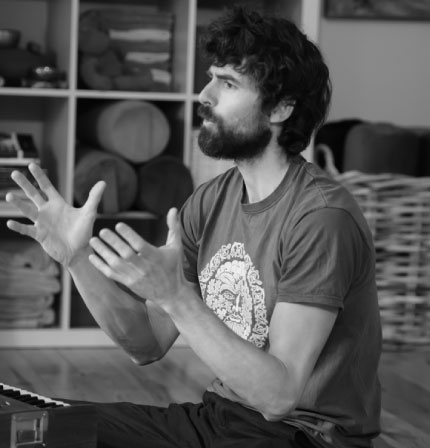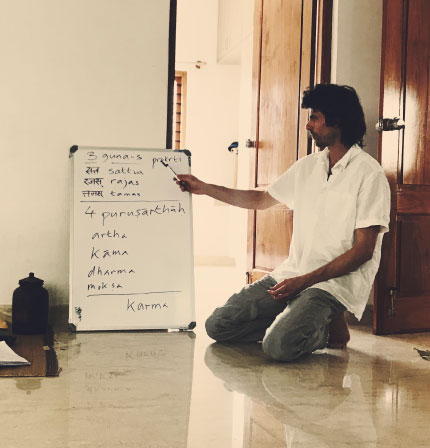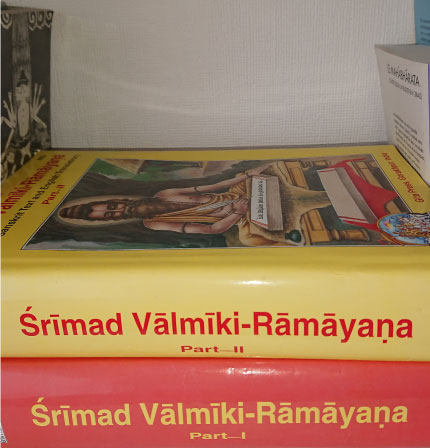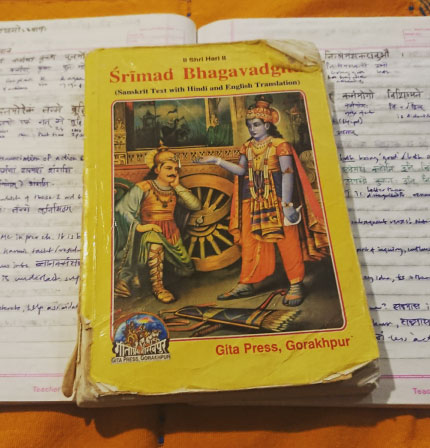
Deepen Your Yoga Experience with the Power of Sanskrit
Sanskṛt is the language of yoga and the broader classical Indian tradition. The texts that define yoga as a śāstra – a time-tested body of practical knowledge and wisdom – are available to us through the medium of this extraordinary language.
James teaches the yoga texts like the Bhagavad Gītā, Yoga Sūtra, Rāmāyaṇa and Devī Māhātmyam for example, working directly from the original Sanskṛt. This brings a depth and vitality to the teaching that goes far beyond what one might access from reading books, and transmits the living teachings in a way that is energetically informed by the lineages James has studied in.
On courses that work from a Sanskṛt text, James usually offers the option to learn and practice reciting the text, inviting us into a much more personal and deepening relationship with it.

Sanskrit – The Exquisitely Well-Made Language
Sanskrit or Saṁskṛta means well done, well made, well put together, well shaped, well formed, refined, polished. Sanskrit/Sanskṛt/Saṁskṛta/Saṁskṛtam is the language that is well made, well put together, well shaped, well formed, polished, refined.
A saṁskāra is a habit or tendency that is well-made and has become robustly established. The Saṁskṛta language is so called because its grammar and form has been so beautifully, powerfully shaped and robustly defined.
Unlocking the Power of Sanskrit
A ‘divine’ language that can help us see
Sanskṛt is known as the language of the divine – working with it can help us see in ways that we may have previously been blind to. Studying the yoga texts in the original Sanskṛt invites us into vast and fresh perspectives, helping us break free of the narrow confines of zeitgeist-skewed perceptions.
An energetically invocative language
All languages contain onomotopoeic words, in which the sound tells or overtly represents the meaning. In Sanskṛt, the correlation between name – nāma and form – rūpa extends through the language. This makes Sanskṛt an energetically invocatory language. When we pronounce and sound the words, we are inviting the energy they encode to enliven and be more predominant in the field of our own vibration.
Attuning to a vibration of yogic harmony
When we recite Sanskṛt yoga texts, such as the Bhagavad Gītā or Yoga Sūtra for example, we are at once attuning ourselves to the many layers of practical teaching encoded in the text and inviting those teachings to penetrate more thoroughly the field of our own awareness.
A beautiful and powerful yoga practice
Sanskṛt recitation of yoga texts is a beautiful and powerful yoga practice that can effectively harness and integrate all layers of the psyche. The recitation is a physical, energetic practice. Smooth, clear recitation facilitates prāṇāyāma – the extension of the life force through refinement of the breath/more efficient breathing. Focusing on the intent and import of the recitation recruits our mental and intellectual capacities. At the same time, it brings an emotional component as we orient in a positive and harmonising direction, orienting towards energy and teachings of harmony and integration. As we observe ourselves in the practice and give ourselves to the text, the text may start to give back to us, providing us with support and revelation as we navigate the current challenges in our lives.
Stimulating and refreshing the brain and nervous system
The well made structure of Sanskṛt means that its sounds stimulate more of the brain than other languages. When people recite Sanskṛt both hemispheres of the brain are activated. This is classic yoga practice: techniques that reinforce the tenuous bridge between the two hemispheres and help to harmonise and bring into mutual support the different but highly complementary potentials of our rational and emotional selves, our analytic and intuitive intelligences.
Training the tongue and harmonising our awareness
Sanskṛt pronunciation is well defined. There are five positions of articulation: guttural, palatal, cerebral, dental and lingual. In other words they range from the first point of possible articulation in the base of the throat, to the last point on the lips, as demonstrated by the mantra Auṃ, beginning with a, the first sound we can possibly articulate, expanding moving up and forwards through ā into ū and then into the labial nasal ṁ. Precise Sanskṛt pronunciation trains the tongue for clear articulation and sends the vibrations upwards to different parts of the brain from where they can irrigate the whole nervous system. Sanskṛt recitation thus invites a ‘medi-state’/ a state of meditative balance and harmony across both hemispheres of the brain.
Refining our speech
Yoga recognises that our words have power. Our relationship to our speech is a key part of our relation to ourselves. Those who study and recite or speak Sanskṛt report greater precision and higher level articulacy in all other languages they speak.






Programs
SIGN UP >

Work With James
LEARN MORE >

Store
COMING SOON
Whole Life Yoga Newsletter
The place to find out first about all James’ programs and offerings, receive articles, recommendations, and access special rates for programs.
